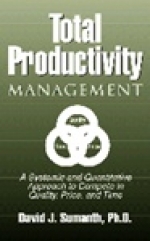Tab Article
Practical coverage of total productivity based on real-world experience with full explanation of common misperceptions
Emphasizes a formal management process following the Productivity Cycle
Provides a well-proven, 10-step implementation procedure
21 detailed case studies selected from more than 300 world-wide applications of TPmgt during the past 17 years
Presents 15 unique features of TPmgt in contrast to well-known thinkers such as Taylor, Deming, Crosby, Juran, Feigenbaum, Ishikawa, Taguchi, and Imai
10 critical benefits of TPmgt (such as automatic "profit-targeting")
Illustrates the 12 basic principles of TPmgt from a wide variety of industries
Action blueprint provided for implementing the philosophy, concept, and methodology of TPmgt
Poised to influence innovative management thinking into the 21st century, Total Productivity Management (TPmgt), written by one of the pioneers of productivity management, has been a decade in the making.
This landmark publication is the most extensive book available on the subject of total productivity management. At a time when downsizing and layoffs are the norm, this innovative and highly organized book shows you how to treat human resource situations with a caring, customer-oriented, yet competitive attitude through integration of technical and human dimensions. This book makes use of a set of proven models and provides a systematic framework and structure to link total productivity to an organization's profitability.
Total Productivity Management describes the tasks required of all constituents in an understandable format that they can relate to and by which regards can be realized for performance in all resource categories including direct labor, administrative staff, managers, professional personnel, materials, liquid assets, technologies, energy, and other areas.


